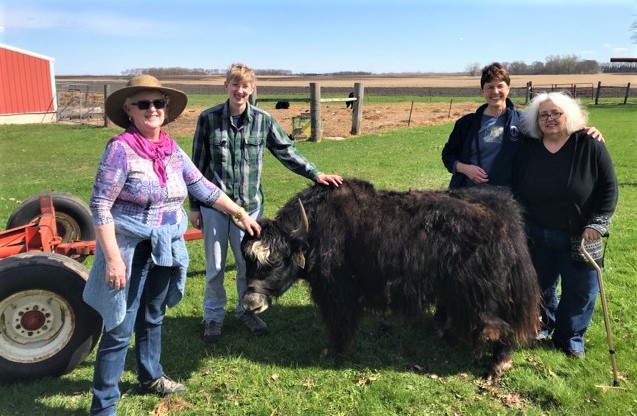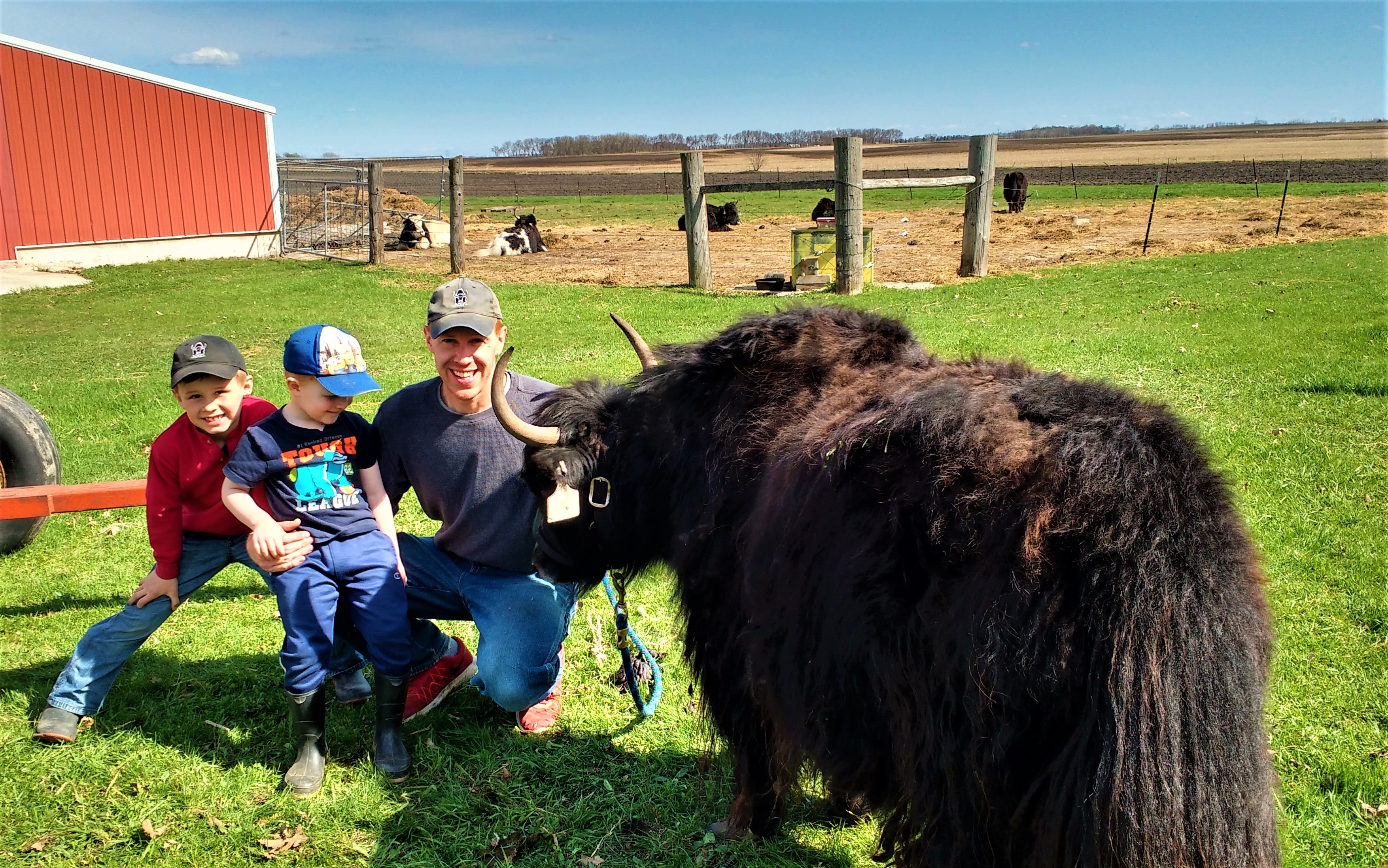By Judith Preckshot
In early May Hazel Lutz, Kianna Fowler, Celeste Grant and I—all members of the Whorling Spinsters—finally made it out to visit Hot Disch Yak Farm after an aborted attempt in mid-April thanks to our big spring snowstorm: ground conditions were not good, and it seems that the yaks were still holding on to their winter coats—as we were! And the point of our visit was to learn about yaks, including how to harvest their fiber. But Saturday, May 4 was a beautiful, sunny and uncharacteristically warm day—perfect for an expedition to the country.
Hot Disch Farm (https://www.hotdischfarm.com/contact.aspx ) is located about two hours drive west from Minneapolis just outside of Raymond, MN. The farmer, Craig Dischinger, is a teacher by day but finds time for his other passion: raising yaks. Craig and his assistant (son) welcomed us warmly and gave us a tour of the farm, mainly the yaks but also the chickens and his woodworking workshop. As Craig says, he likes to “yak about yaks,” which was great because we were there to learn.
Yaks originated in Asia, specifically the Himalayan slopes. To survive the cold winters, they grow a woolly down undercoat that is so soft that it has been compared to cashmere, once the much longer and coarser hairs are removed. (This is a tedious chore if you do it by hand, but the resulting down fiber is soft and luxurious spun by itself or blended with silk, for example.) The colder it gets, the thicker the undercoat. Apparently, it’s not just because we live in a frigid climate that Minnesota-bred yaks produce the finest quality fiber: as Craig explained, it is also thanks to the grasses that grow in especially nutrient-rich soil and fed by ample rain. Like bison, yaks don’t do well on corn-rich cattle feed: they have very efficient digestive systems and thrive on natural grasses, producing healthier, leaner meat. But they will eat a variety of vegetation and are especially fond of apples and pumpkins, Craig relates.
Yaks are surprisingly small, weighing in at about 600 lbs for females and 1,000-12,00 lbs for bulls. (By contrast, a cow will weigh about 1,600 lbs and a bull at around 2,600 lbs). Nonetheless their impressive horns make you want to keep a safe distance—especially from the young males that are kept separate from the cows (three of these “bad boys” were slated for slaughter the next week!), the ladies more amenable to being tethered and approached by strangers. Yaks also live longer than cows, surviving up to 25-28 years, whereas the average dairy cow lives 4-6 years. And unlike cows, which are boringly the same, they each have a distinctive personality, and they all have names. When we arrived, Craig had two of his yaks (Gertrude and Dottie) waiting for us to learn how to comb out the winter coat, which is done with sturdy plastic combs with teeth fairly widely spaced. The hair comes out in clumps, is not greasy like sheep’s wool, but will have to be washed prior to processing. Craig has two different breeds: the Royal, which has black and white coloring, and the Native, which has black hair veering on brown. Craig sends most of his fiber to be processed by a mill; it is returned to him as yarn, which he sells to knitters. But he keeps aside some fiber for local spinners, so keep that in mind if you are looking for a yak spinning experience. There are also yak pelts, tanned yak hides, amazing yak tails (apparently in demand for Tibetan wedding ceremonies), and, of course, yak meat (on his website, Craig claims that “Once you try yak, you don’t go back!”).
The Whorling Spinsters meet every first Tuesday of the month at 6:30. It’s a casual group of spinners who love to spin together and explore different spinning techniques and fibers. This summer is the summer of the spindles. We inaugurated it with the walking wheel, learning how to do the long draw on the spindle mechanism. Next month it’s the Navajo spindle. Come join us!




